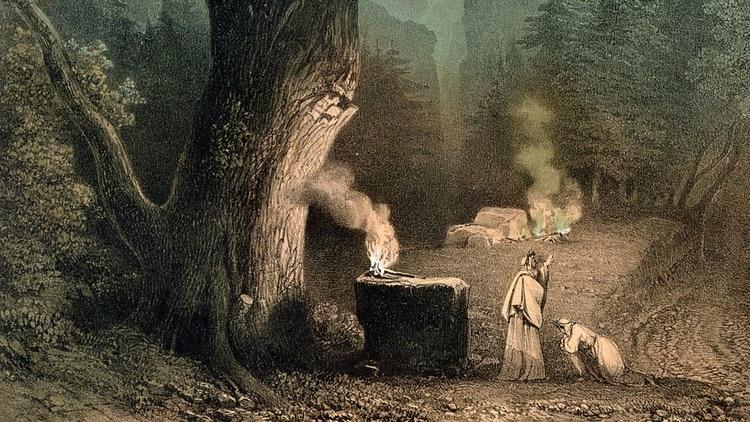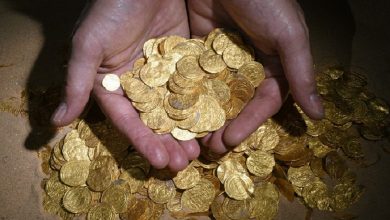Who were the mysterious druids: wise ancient monks or ignorant and savage tribe that sacrificed humans?

Who were the mysterious druids: wise ancient monks or ignorant and savage tribe that sacrificed humans?
They were not an unknown phenomenon: Julius Caesar, Pliny the Elder and Cicero, among many others. “After having prepared the sacrifices and feasts under the trees, they bring two white bulls whose horns have been bandaged in their white tunic, a druid climbs the tree to cut the mistletoe with his gold sickle, and others, dressed in the same. They receive it, then kill the sacrificial animals and pray that the god will reward them with their gifts.”
This story by Pliny the Elder (Gaius Plinius Secundus), writer, scientist, naturist and Roman military -23 to 79 of the Christian Era-, is one of the few echoes that have survived the centuries. Because the druids, priests, sorcerers, seers, philosophers, date from 200 BC… but it is assumed -although without solid evidence- that they lived in Ireland, northern Spain, Gaul (France and northern Italy) and other lands of Celtic Europe before the Iron Age, the last stage of Prehistory. A thousand years before the first concrete references about its existence!
Maybe that’s why they are a mystery. A town or clan or ghostly sect, but with an obvious and very popular trace: it would be the hidden origin of Halloween, one of its rites, which Rome repressed first and then banned… for its brutality.
Of course, it was not then a party of hollow and illuminated pumpkins, candy, children knocking on doors and throwing their slogan: “Sweet or trick!”
Among the druids, the root was the Samagín, the god of death: ceremony that included human sacrifices to guess the future and connect the world of the living with the world of the dead…, and that the historian Cornelio Tacitus defined with eleven words not exempt of beauty:
They consulted the gods in the throbbing innards of men.
But just as they killed, they dared to save lives. With preparations of forest herbs, and in extreme cases, with caesarean sections and skull trepanations, as proven by certain instruments found by archaeologists. The waters are divided…
According to the vulgar, they were magicians and sorcerers. But according to historians and researchers, they had the rank of philosophers and theologians.
Believe it or not, the sanctuary of Stonehenge, the great and mysterious megalithic complex of southern England, inspired in the 18th century a current that advocated druidic restoration, and even today it is a point-emblem of Neodruism: groups that evoke, example, the harvest of mistletoe: the sixth lunar day was collected with a gold sickle, and with its berries prepared healing concoctions.
Why the mistletoe? Because it is a parasitic plant that grows around the oak …, and one of the meanings of the word “druid” is “the one who knows the oak”.
The English historian Ronald Hutton is sceptical: “We really can not know anything with certainty about the Druids, although they certainly existed, in any case they were only legendary figures.”
But not for Emperor Julius Caesar, who in his celebrated book on the war of Gaul describes them as “a religious group of high importance, responsible for worship, sacrifices, divination, the oracle, judicial issues, excommunication of members of their community (…) and are exempt from military service and the payment of taxes”.
But the writers Diodorus Siculus and Strabo go even further: “So dreaded and respected were the druids, that if they stood between two armies…, they could stop a battle.”
As for its instruction, according to the Latin geographer Pomponio Mela, “it was secret, impenetrable, carried out in caves and forests, and was completed over twenty years.”
Finally, other polymatas (superpersonal) compare them with Pythagoras in their doctrine of the immortality of the soul and reincarnation.
But again, the waters are divided…
Sages, silent herbalist monks, peacemakers, eternal scholars according to a current…, another does not hesitate to install them in the category of “barbarians”, especially for their human sacrifices. Some of its defenders swear that they only practiced them with criminals – that is, the death penalty, still in force today – but most tend to include innocents as well.
Sacrifices dedicated to the deities ‘Teutates, Esus and Taranis’, with atrocious variants: gallows, dagger in the chest to read the future according to the direction taken by the torrent of blood, and death by fire: the condemned was placed inside a big doll of wood -the wicker man, they called it- that burned until nothing remained of both: only ashes….
But… Julio César or some of the historians and theoreticians about the mystery of the druids, met one “live and direct”?
According to his testimony, Marco Tulio Cicero. The druid in person was the Gaulish Divitian, a member of the tribe of the Aedui, “who knew a great deal about the natural world and who dominated divination through augury,” he wrote. Actually, more noise than nuts. It is possible that, in addition to the classic tunics, they sometimes wore aggressive robes capable of instilling fear.
Tacitus narrates that “when the Roman army, led by Cayo Suetonio Paulino, attacked the island of Mona, the soldiers were terrified by the appearance of a band of druids who, with their hands raised towards the sky, shouting terrible curses and dressed in a way very strange, they almost managed to put them to flight, but the courage of the Romans could do more, the druids fled, and their sacred groves of Mona were cut down. In truth, they are wild and ignorant.
Portrayed in the first Irish sagas of their pre-Christian past, they are awarded a very high social status. But after the arrival of Christianity, the Druid influence in Irish society fell rapidly. Of wise men, philosophers and owners of extraordinary powers…, they fell to the level of simple sorcerers and sorcerers very unreliable.
A heavy curtain on this prestige, and without the modern arts – marketing, for example – to recover it.
Ignorance about his appearance and dress became clear, though not decisively, during an excavation in Deal, Kent County. Appeared the one that soon would be baptized like “the warrior of Deal”: a man buried between 200 and 150 before Christ, with sword and shield, and a crown too light as to be a helmet. Crown made of bronze, with a wide band around the head and a thin fringe as a stop… which could well have been a druid.

Always according to Pliny the Elder, Emperor Tiberius, who ruled between 14 and 35 AD, passed laws that prohibited not only Druids: also fortune tellers and healers, convinced that these measures would end human sacrifices. But the Emperor Claudius -41 to 54-, also by law, gave them the final blow: he forbade their religious practices, reducing them almost to nothing.
However, his shadow did not disappear completely and forever. It was reborn in popular culture with the first wave of Romanticism with the novel “Les Martyris”, from 1809, written by François-René de Chateaubriand, which narrates the unsuccessful love between a Druid priestess and a Roman soldier. And it is true historically that the aria “Casta Diva”, from the opera Norma, composed by Vicenzo Bellini, has druid roots due to the connection of the protagonist with the Goddess of the Moon.
The latest-generation research was devastating about the life, rise and fall of the druids, druidism and neodruidism. Of high priestly class, of philosophers, of influential wise men, they were jibarized to a barbarous and savage tribe for which human sacrifices were common currency, they believed themselves as direct descendants of the God of Death, reincarnated in animals, lit gigantic bonfires in hills, and they danced around it with grotesque masks to scare away evil spirits.
Maybe yes, maybe no…
To such a remote story written over the centuries, with the foreseeable inaccuracies, fits Hamlet’s words in the fifth scene of the first act: “There are more things between heaven and earth, Horacio, from which your philosophy dreams.”





I love reading more about history and the past. Where can I get much more of the history,Traditionchurch and science